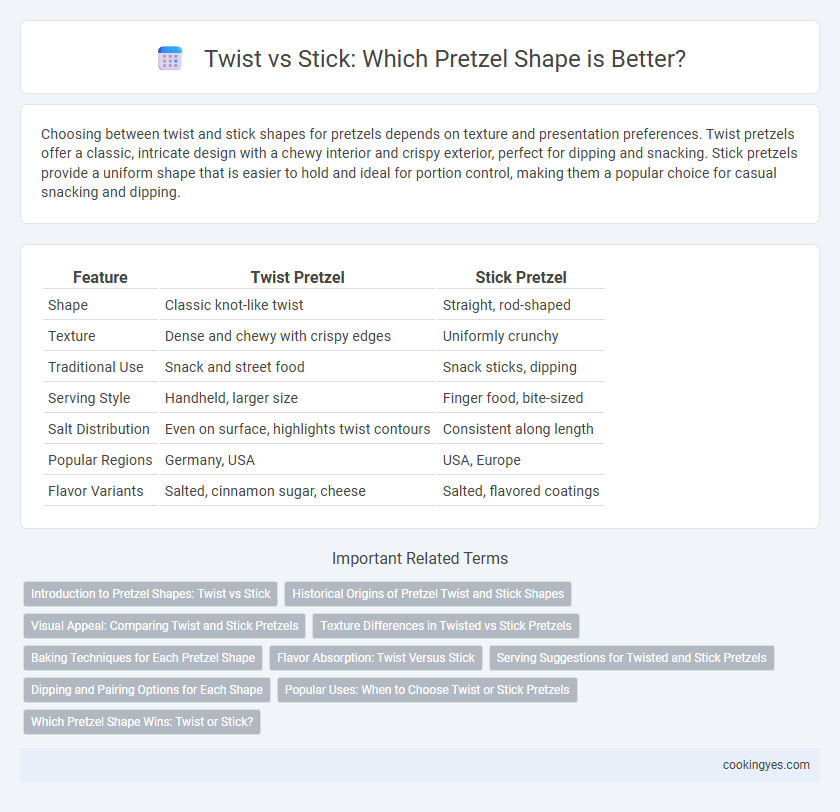Choosing between twist and stick shapes for pretzels depends on texture and presentation preferences. Twist pretzels offer a classic, intricate design with a chewy interior and crispy exterior, perfect for dipping and snacking. Stick pretzels provide a uniform shape that is easier to hold and ideal for portion control, making them a popular choice for casual snacking and dipping.
Table of Comparison
| Feature | Twist Pretzel | Stick Pretzel |
|---|---|---|
| Shape | Classic knot-like twist | Straight, rod-shaped |
| Texture | Dense and chewy with crispy edges | Uniformly crunchy |
| Traditional Use | Snack and street food | Snack sticks, dipping |
| Serving Style | Handheld, larger size | Finger food, bite-sized |
| Salt Distribution | Even on surface, highlights twist contours | Consistent along length |
| Popular Regions | Germany, USA | USA, Europe |
| Flavor Variants | Salted, cinnamon sugar, cheese | Salted, flavored coatings |
Introduction to Pretzel Shapes: Twist vs Stick
Pretzel shapes vary primarily between the classic twist and the simple stick, each offering distinct textures and baking qualities. The twist shape provides a chewy interior with a crisp exterior due to its layered dough structure, enhancing flavor absorption from toppings like salt and seeds. Stick-shaped pretzels offer a uniform bake and a denser bite, often favored for dipping and snacking versatility in both soft and hard pretzels.
Historical Origins of Pretzel Twist and Stick Shapes
The pretzel twist shape originates from European monks in the Middle Ages who folded dough to symbolize arms crossed in prayer, reflecting its religious and cultural significance. In contrast, the stick shape, dating back to more recent centuries, emphasizes convenience and ease of consumption, often associated with street food vendors. Historical records show the twisted form became synonymous with pretzels across Germany and Switzerland, while stick pretzels gained popularity in urban settings for snacking.
Visual Appeal: Comparing Twist and Stick Pretzels
Twist pretzels showcase a distinctive, traditional knot shape that enhances visual appeal with intricate loops and symmetrical design, making them instantly recognizable. Stick pretzels offer a sleek, linear form emphasizing simplicity and uniformity, which appeals through minimalistic elegance and ease of stacking. The twist shape's complexity adds artisanal value, while the stick shape highlights convenience and modern presentation in bakery displays.
Texture Differences in Twisted vs Stick Pretzels
Twisted pretzels feature a knot-like shape that creates multiple layers, resulting in a denser and chewier texture with a satisfying crunch on the outside. Stick pretzels have a uniform, elongated shape that yields a crisp and dry texture throughout, making them lighter and easier to bite into. The varying thickness in twisted pretzels contributes to a more complex mouthfeel compared to the consistent texture of stick pretzels.
Baking Techniques for Each Pretzel Shape
Twist-shaped pretzels require careful hand-twisting to ensure even dough thickness, which promotes uniform baking and a chewy interior with a well-defined crust. Stick-shaped pretzels, baked as straight or slightly curved rods, benefit from precise dough rolling to maintain consistent thickness, allowing for quicker, more even heat penetration and a crispier texture. Adjusting baking times and temperatures according to shape ensures optimal Maillard reaction, enhancing flavor and color development for each pretzel form.
Flavor Absorption: Twist Versus Stick
The twist shape of a pretzel enhances flavor absorption by increasing surface area and creating pockets where seasonings and toppings can cling more effectively. In contrast, stick-shaped pretzels have a uniform surface that limits seasoning adherence, resulting in a subtler taste experience. Optimal flavor infusion is achieved with twists due to their structural complexity and texture variation.
Serving Suggestions for Twisted and Stick Pretzels
Twisted pretzels offer a classic, visually appealing shape ideal for serving with mustard, cheese dips, or sweet glazes, enhancing their traditional flavor profile. Stick pretzels provide a convenient, bite-sized option perfect for snacking with individual portions of hummus, ranch dip, or chocolate sauce. Both shapes complement a variety of toppings, making them versatile choices for casual gatherings or gourmet presentations.
Dipping and Pairing Options for Each Shape
Pretzel twists offer multiple nooks and crannies perfect for holding thick dips like cheese fondue or spicy mustard, enhancing the flavor experience with every bite. Pretzel sticks provide a uniform surface ideal for dipping into smooth sauces such as honey mustard or beer cheese, allowing for easy, mess-free pairing with beverages like craft beer. Both shapes complement different dipping preferences, with twists excelling in sauce retention and sticks favored for convenient snacking.
Popular Uses: When to Choose Twist or Stick Pretzels
Twist pretzels are popular for their classic, intricate shape that holds toppings well, making them ideal for serving with dips or as snacks at parties and sporting events. Stick pretzels, with their elongated form, are favored for dipping into mustard, cheese, or chocolate and are commonly used as convenient finger foods in lunch boxes and snack platters. Choosing twist pretzels enhances presentation and texture variety, while stick pretzels offer practicality and ease of eating for casual and on-the-go occasions.
Which Pretzel Shape Wins: Twist or Stick?
When comparing pretzel shapes, the twist offers a classic appearance and evenly distributes salt and seasoning, enhancing flavor complexity. The stick shape, meanwhile, provides a convenient, portable snack ideal for dipping and on-the-go consumption. Preference often depends on texture and use, with twists favored for traditional taste and sticks prized for practicality.
Twist vs stick for pretzel shape Infographic

 cookingyes.com
cookingyes.com